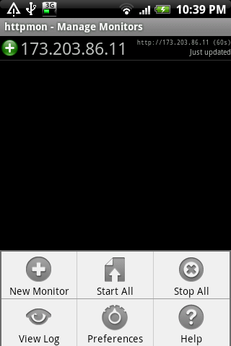Monitor Servers from Your Android Device with httpmon

Productivity Sauce
Checking whether a specific Web server is up and running is as easy as issuing the ping command in the terminal, but if you are looking for a more versatile tool that you can use while on the move, try httpmon for Android. For starters, this nifty tool lets you set up multiple monitoring profiles, which can come in handy when you want to keep an eye on several servers. Besides ping, httpmon supports other monitoring options, such as response time, response code, and specific header and content strings. Better yet, you can specify multiple criteria; for example, you can configure httpmon to ping a specific server and check its response time in one go.
Creating a monitoring profile is as easy as it gets. Launch httpmon on your Android device, press the Menu button and tap on New Monitor. Give the new profile a name, press the Edit button, and specify the server's URL and the polling interval. In the Conditions section, select the Ping item from the drop-down list and press the Add button.
To alert you about server failures, httpmon can use notifications and text messages. To set up a notification, select Send Notifications from the drop-down list in the Actions section and press Add. Specify the desired options, and your profile is ready to go. Press the Menu | Start All button to activate the created profile or profiles and let httpmon do its job.
Finally, if you want to tweak httpmon's settings, press the Menu | Preferences button. Here you can enable automatic start-up and background notifications as well as specify connection and read timeouts.
Comments
comments powered by DisqusSubscribe to our Linux Newsletters
Find Linux and Open Source Jobs
Subscribe to our ADMIN Newsletters
Support Our Work
Linux Magazine content is made possible with support from readers like you. Please consider contributing when you’ve found an article to be beneficial.

News
-
Two New Distros Adopt Enlightenment
MX Moksha and AV Linux 25 join ranks with Bodhi Linux and embrace the Enlightenment desktop.
-
Solus Linux 4.8 Removes Python 2
Solus Linux 4.8 has been released with the latest Linux kernel, updated desktops, and a key removal.
-
Zorin OS 18 Hits over a Million Downloads
If you doubt Linux isn't gaining popularity, you only have to look at Zorin OS's download numbers.
-
TUXEDO Computers Scraps Snapdragon X1E-Based Laptop
Due to issues with a Snapdragon CPU, TUXEDO Computers has cancelled its plans to release a laptop based on this elite hardware.
-
Debian Unleashes Debian Libre Live
Debian Libre Live keeps your machine free of proprietary software.
-
Valve Announces Pending Release of Steam Machine
Shout it to the heavens: Steam Machine, powered by Linux, is set to arrive in 2026.
-
Happy Birthday, ADMIN Magazine!
ADMIN is celebrating its 15th anniversary with issue #90.
-
Another Linux Malware Discovered
Russian hackers use Hyper-V to hide malware within Linux virtual machines.
-
TUXEDO Computers Announces a New InfinityBook
TUXEDO Computers is at it again with a new InfinityBook that will meet your professional and gaming needs.
-
SUSE Dives into the Agentic AI Pool
SUSE becomes the first open source company to adopt agentic AI with SUSE Enterprise Linux 16.


Innovative alternative
Other tool
website monitoring
website monitoring
Website monitoring
Works great